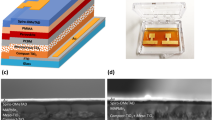Abstract
Inorganic perovskite solar cells (IPSCs) have attained attention due to their excellent thermal and phase stability. In this work, we demonstrate a novel approach for fabricating IPSCs, using the strategies of interface passivation and anti-solvent before spin-coating perovskite. Poly(methyl methacrylate) (PMMA) and chlorobenzene (CB) are used as passivator and anti-solvent, respectively. The CB improves the perovskite crystal morphology. Meanwhile, PMMA passivates the defects between poly(3, 4-ethylenedioxythiophene)-poly(styrenesulfonate) (PEDOT: PSS) and perovskite layer, thus increasing the short-circuit current. Excitingly, we find that PMMA benefits the grain boundaries (GBs) of perovskite, which makes it more humidity-resistant, increasing the stability of perovskite film. Especially, PMMA mitigates interfacial charge losses, and the devices based on CsPbI3−xBrx passivated by PMMA exhibit the power conversion efficiency (PCE) much higher than those based on pure CsPbI3−xBrx.
Similar content being viewed by others
References
TIAN J J, XUE Q F, YAO Q, et al. Inorganic halide perovskite solar cells: progress and challenges[J]. Advanced energy materials, 2020, 10(23): 2000183.
LI Z Z, ZHOU F G, WANG Q, et al. Approaches for thermodynamically stabilized CsPbI3 solar cells[J]. Nano energy, 2020, 71: 104634.
PARIDA B, RYU J, YOON S, et al. Two-step growth of CsPbI3−xBrx films employing dynamic CsBr treatment: toward all-inorganic perovskite photovoltaics with enhanced stability[J]. Journal of materials chemistry, 2019, 7(31): 18488–18498.
FU Q, TANG X, HUANG B, et al. Recent progress on the long-term stability of perovskite solar cells[J]. Advanced science, 5(5): 1700387.
BACK H, KIM G, KIM J, et al. Achieving long-term stable perovskite solar cells via ion neutralization[J]. Energy & environmental science, 2016, 9(4): 1258–1263.
GREEN M A, HO-BAILLIE A, SNAITH H J. The emergence of perovskite solar cells[J]. Nature photonics, 2014, 8(7): 506–514.
WANG Y, ZHANG T, KAN M, et al. Efficient α-CsPbI3 photovoltaics with surface terminated organic cations[J]. Joule, 2018, 2(10): 2065–2075.
WANG K, JIN Z, LIANG L, et al. Chlorine doping for black γ-CsPbI3 solar cells with stabilized efficiency beyond 16%[J]. Nano energy, 2019, 58: 175–182.
KE F, WANG C, JIA C, et al. Preserving a robust CsPbI3 perovskite phase via pressure-directed octahedral tilt[J]. Nature communications, 2021, 12(1): 1–8.
LIU C, LI W, ZHANG C, et al. All-inorganic CsPbI2Br perovskite solar cells with high efficiency exceeding 13%[J]. Journal of the American Chemical Society, 2018, 140(11): 3825–3828.
SHANG Y, FANG Z, HU W, et al. Efficient and photostable CsPbI2Br solar cells realized by adding PMMA[J]. Journal of semiconductors, 2021, 42(5): 050501.
LIU T H, CHEN K, HU Q, et al. Inverted perovskite solar cells: progresses and perspectives[J]. Advanced energy materials, 2016, 6(17): 1600457.
CHEN K, HU Q, LIU T, et al. Charge-carrier balance for highly efficient inverted planar heterojunction perovskite solar cells[J]. Advanced materials, 2016, 28(48): 10718–10724.
XIA Y, DAI S. Review on applications of PEDOTs and PEDOT: PSS in perovskite solar cells[J]. Journal of materials science: materials in electronics, 2020, 32(10): 12746–12757.
RAHAQ Y, MOUSSA M, MOHAMMAD A, et al. Highly reproducible perovskite solar cells via controlling the morphologies of the perovskite thin films by the solution-processed two-step method[J]. Journal of materials science-materials in electronics, 2018, 29(19): 16426–16436.
CHEN C L, ZHANG S S, WU S H, et al. Effect of BCP buffer layer on eliminating charge accumulation for high performance of inverted perovskite solar cells[J]. Royal society of chemistry advances, 2017, 7(57): 35819–35826.
TSAI C H, LIN C M, KUEI C H. Investigation of the effects of various organic solvents on the PCBM electron transport layer of perovskite solar cells[J]. Coatings, 2020, 10(3): 273.
ZHANG T, WANG F, CHEN H, et al. Mediator antisolvent strategy to stabilize all-inorganic CsPbI3 for perovskite solar cells with efficiency exceeding 16%[J]. ACS energy letters, 2020, 5(5): 1619–1627.
YUAN B L, LI C, YI W C, et al. PMMA passivated CsPbI2Br perovskite film for highly efficient and stable solar cells[J]. Journal of physics and chemistry of solids, 2021, 153: 110000.
AVA T T, JEONG H J, YU H M, et al. Role of PMMA to make MAPbI3 grain boundary heat-resistant[J]. Applied surface science, 2021, 558: 149852.
DING D, LANZETTA L, LIANG X, et al. Ultrathin polymethylmethacrylate interlayers boost performance of hybrid tin halide perovskite solar cells[J]. Chemical communications, 2021, 57(41): 5047–5050.
WANG F, YU H, XU H H, et al. HPbI3: a new precursor compound for highly efficient solution-processed perovskite solar cells[J]. Advanced functional materials, 2015, 25(7): 1120–1126.
PEI Y, LIU Y, LI F, et al. Unveiling property of hydrolysis-derived DMAPbI3 for perovskite devices: composition engineering, defect mitigation, and stability optimization[J]. IScience, 2019, 15: 165–172.
Author information
Authors and Affiliations
Corresponding author
Additional information
This work has been supported by the National Natural Science Foundation of China (Nos.61904100 and 11604194), and the Education Department of Shaanxi Province Serves the Local Special Plan Project (No.17JF006).
Statements and Declarations
The authors declare that there are no conflicts of interest related to this article.
Rights and permissions
About this article
Cite this article
Zhang, M., Zhang, F., Shi, K. et al. Polymer passivation of defects in inorganic perovskite solar cells. Optoelectron. Lett. 18, 338–342 (2022). https://doi.org/10.1007/s11801-022-1187-6
Received:
Revised:
Published:
Issue Date:
DOI: https://doi.org/10.1007/s11801-022-1187-6




